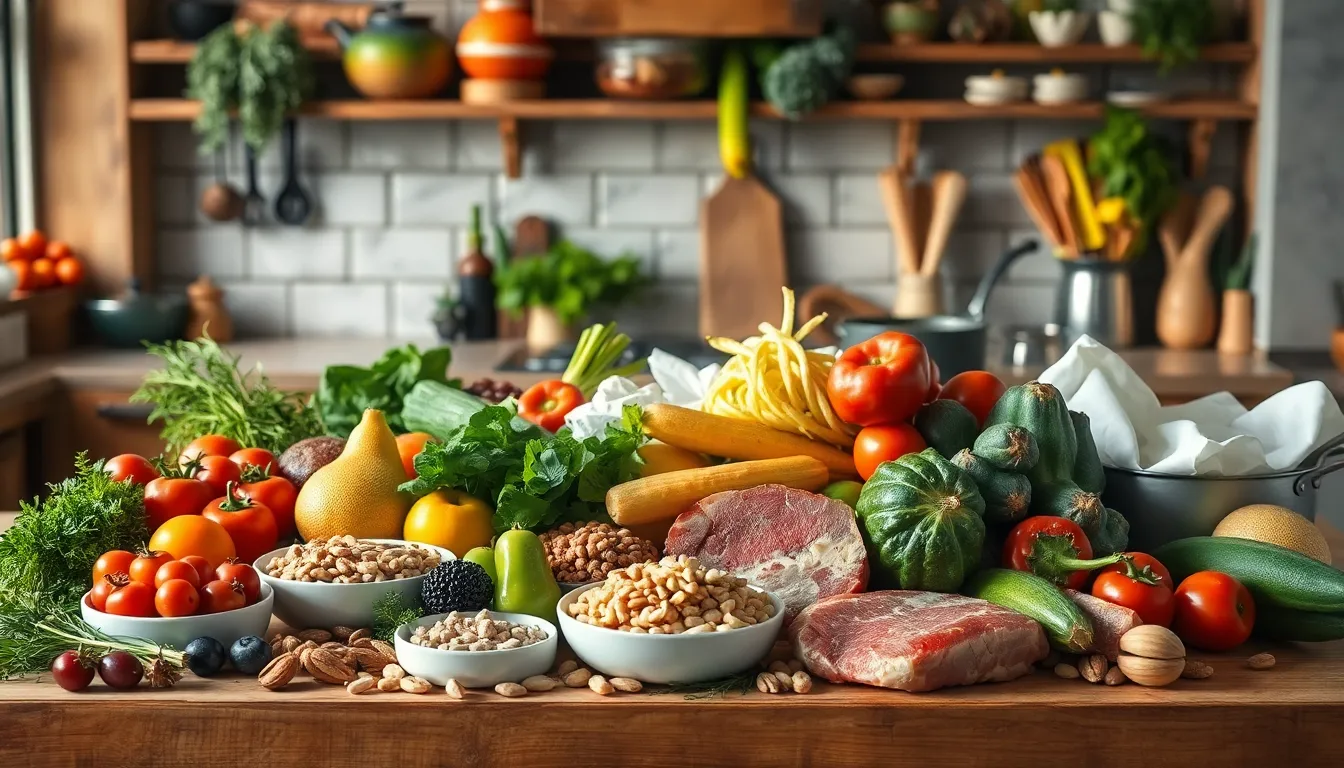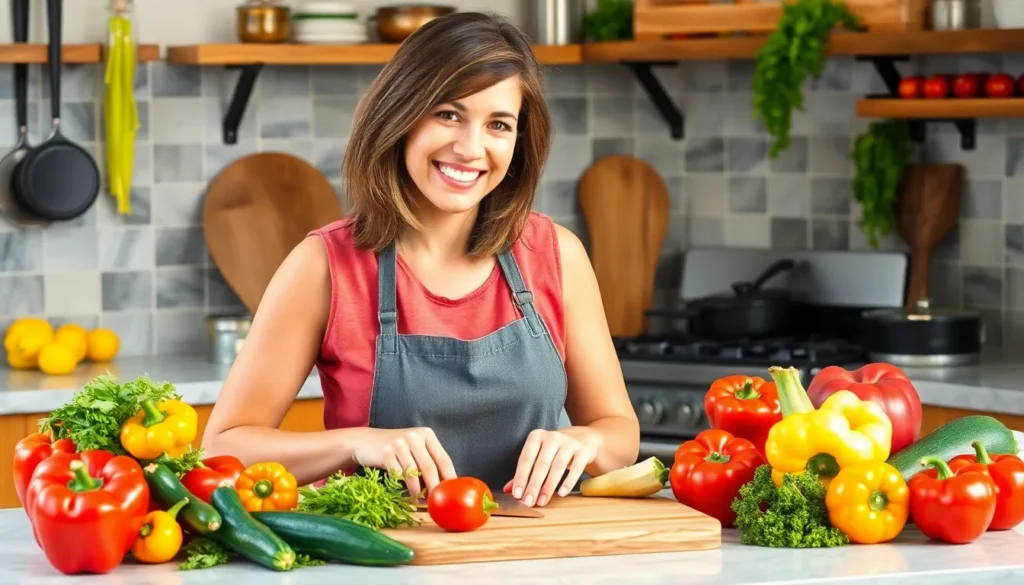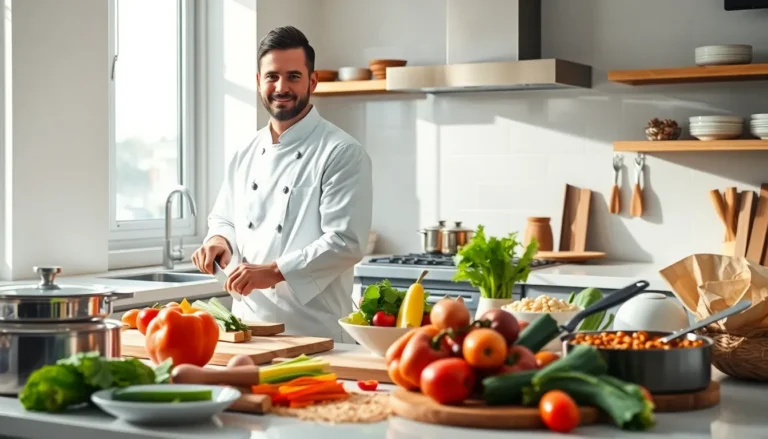Table of Contents
ToggleIn a world where kale reigns supreme and quinoa is practically royalty, paleo cooking techniques stand out like a caveman at a vegan potluck. This back-to-basics approach to cooking not only honors our ancestors but also brings flavor and fun back to the kitchen. Imagine whipping up meals that are as satisfying as they are nutritious, all while channeling your inner hunter-gatherer.
Overview of Paleo Cooking Techniques
Paleo cooking techniques emphasize simple preparation methods that align with the natural foods consumed by early humans. Roasting over an open flame brings out rich flavors in meats and vegetables, providing a primal cooking experience. Grilling adds a smoky essence, perfectly suited for various proteins and seasonal produce.
Sautéing allows for quick meal preparation, retaining nutrients while enhancing the taste of fresh ingredients. Steaming preserves the natural crispness and color of vegetables, ensuring an appetizing presentation. Baking, particularly in cast iron, creates a perfect environment for evenly cooked dishes, making it suitable for items like frittatas or roasted meats.
Fermentation has gained popularity in paleo cooking, enhancing flavors and contributing to gut health. Preparing probiotic-rich foods like sauerkraut and kimchi offers dynamism to meals while promoting digestive wellness. Utilizing tools such as food processors and spiralizers makes it easy to create dishes that showcase fresh, whole foods.
Batch cooking plays a vital role in meal planning. Cooking large quantities of staples like roasted vegetables or bone broth supports a time-efficient approach to nutritious paleo meals. Freezing portions extends their shelf life, allowing for an easy grab-and-go option on busy days.
Experimenting with these techniques fosters creativity in the kitchen. Using spices and herbs expands flavors beyond basic seasonings, providing satisfaction with each bite. Paleo cooking encourages exploration while focusing on wholesome ingredients for nourishing and enjoyable dishes.
Key Principles of Paleo Cooking

Paleo cooking focuses on unprocessed foods and a return to traditional culinary practices. It emphasizes nutrient-dense ingredients that our ancestors consumed.
Focus on Whole Foods
Whole foods take center stage in paleo cooking. Incorporating fruits, vegetables, nuts, seeds, and high-quality meats provides balanced nutrition. Choosing seasonal produce boosts flavor while ensuring freshness. Local farmers’ markets often provide an excellent source of these ingredients. Avoiding refined sugars and grains maintains the integrity of the diet. Meal preparation often includes whole food snacks like sliced veggies and homemade jerky to sustain energy levels throughout the day. Prioritizing clean, whole foods simplifies grocery shopping and meal planning.
Emphasis on Natural Ingredients
Natural ingredients define the paleo approach. Unprocessed items free from additives or artificial flavors support health goals. Fresh herbs and spices enhance dishes without compromising nutritional value. Grass-fed meats, wild-caught fish, and free-range poultry offer essential nutrients and healthy fats. Organic produce minimizes exposure to pesticides, aligning with the paleo philosophy. Cooking methods like roasting or grilling amplify the natural flavors of these ingredients. Using pure ingredients fosters creativity in the kitchen and encourages exploration of diverse flavor profiles.
Essential Cooking Methods
Paleo cooking emphasizes techniques that enhance flavor while retaining nutrients. Some preferred methods include grilling, roasting, steaming, and sautéing, showcasing the beauty of whole foods.
Grilling and Smoking
Grilling imparts a distinct smoky flavor to meats and vegetables. This method captures natural juices while achieving a satisfying char. Additionally, smoking adds depth to dishes, using wood chips like hickory or applewood for unique flavor profiles. Many find that marinating proteins beforehand enhances taste and tenderness, making grilled meals even more enjoyable.
Roasting and Baking
Roasting allows ingredients to caramelize, bringing out their natural sweetness. This technique works well for root vegetables and meats alike. Baking, particularly in cast iron, creates a wonderfully crisp crust while keeping the inside moist. Cooking times vary, so monitoring the temperature helps ensure thorough cooking without drying out the food. Herbs can elevate seasoning, allowing roasted dishes to burst with flavor.
Steaming and Sautéing
Steaming preserves the delicate texture and nutrients of vegetables. Quick cooking times maintain vibrant colors and crispness, making steamed greens a healthy choice. Conversely, sautéing encourages browning, enhancing flavor and aroma. Using healthy fats, such as olive oil or clarified butter, during sautéing contributes to the dish’s overall richness. This two-method approach allows cooks to create balanced, nutrient-dense meals efficiently.
Tools and Equipment for Paleo Cooking
Paleo cooking thrives on the right tools and equipment. These items enhance preparation and cooking efficiency while ensuring adherence to the principles of the diet.
Must-Have Kitchen Gadgets
Essential kitchen gadgets make paleo cooking enjoyable. A good quality knife allows for precise chopping of fresh produce. A spiralizer transforms vegetables into noodles, adding creativity to meals. A food processor speeds up chopping and blending for sauces and dips. Measuring cups and spoons ensure accurate ingredient portions, supporting nutritional goals. Lastly, a mandoline slicer provides uniform cuts, enhancing presentation.
Recommended Cookware
Optimal cookware enhances the paleo cooking experience. Cast iron skillets excel at searing and roasting meats while providing even heat distribution. Stainless steel pots and pans are durable for various cooking techniques. Non-toxic baking sheets ensure safe roasting without chemicals. Slow cookers make meal preparation easy, allowing for flavor melding over hours. Using glass storage containers helps maintain food quality and eliminates plastic concerns, promoting a healthier kitchen environment.
Paleo cooking techniques offer a refreshing approach to meal preparation that honors the simplicity and flavor of natural ingredients. By embracing these methods, anyone can create delicious dishes that nourish the body and satisfy the palate.
The focus on whole foods and traditional cooking practices not only enhances the nutritional value but also fosters a deeper connection to food. With the right tools and techniques, the journey into paleo cooking becomes an enjoyable exploration of flavors and textures.
Ultimately, adopting these techniques encourages a healthier lifestyle while celebrating the joy of cooking. Embracing the essence of ancestral diets can lead to a fulfilling culinary experience that resonates with both health and taste.



